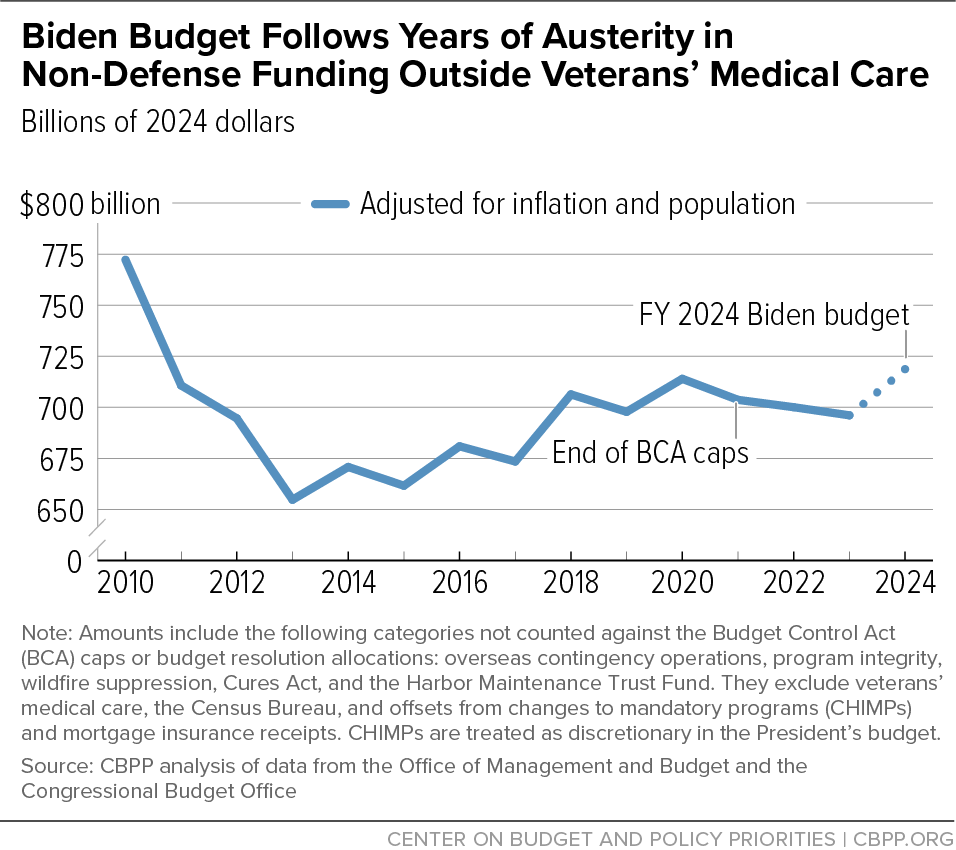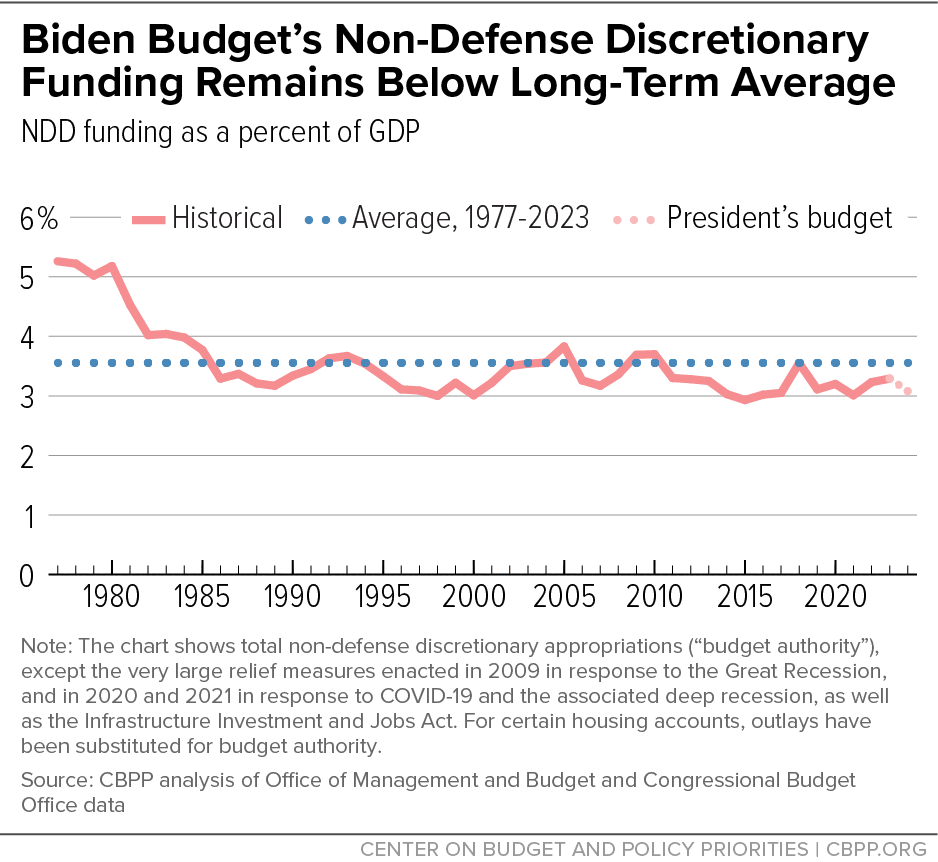President Biden’s budget for 2024 proposes important increases in non-defense discretionary appropriations to expand investments in areas such as child care, K-12 education, low-income housing, environmental protection, financial aid for college students, mental health services, and scientific research. These proposals would continue efforts to reverse the squeeze on non-defense appropriations brought about by the Budget Control Act (BCA) of 2011. But even with the increases, non-defense appropriations (excluding veterans’ medical care) under the proposed budget remain below the 2010 level when adjusted for inflation and population growth. Further, when measured as a percentage of gross domestic product (GDP), the President’s proposed non-defense funding remains below the long-term average over the previous 47 years.
President Biden’s approach is in stark contrast to the approach being urged by many in the new Republican majority in the House, who are calling for rolling back overall appropriations to the 2022 level in 2024, with no increases to cover growing costs, increased needs, or new priorities. Details remain unclear, but the required cuts to important domestic needs would be extremely damaging under any likely scenario that meets the Republicans’ pledge, as a recent series of analyses produced by federal agencies shows.[1]
The term “non-defense discretionary appropriations” (NDD) refers to programs where Congress exercises discretion to set funding levels through the annual appropriations process — in contrast to entitlements and other “mandatory” programs where funding is determined by the underlying law governing the program. NDD represents just over one-seventh of the federal budget but supports a wide range of federal functions and services, such as air traffic control, law enforcement and courts, weather forecasting and warnings, administration of Social Security and Medicare, support for education, mental health and substance use treatment, rural development, small business assistance, public health programs, help with child care costs, job training, medical research, housing programs, and many other things.
While veterans’ medical care is technically part of NDD, the President’s budget treats it as a separate category (CBPP has also taken this approach in recent analyses). This is because veterans’ medical care is by far the largest item of NDD funding, accounting for almost one-sixth of the total in 2023. It has been growing much faster than the rest of NDD due to rising costs of meeting veterans’ health care needs and policymakers’ view that they must fund veterans’ health care at levels required to meet need. This view does not carry over to other areas like child care, housing, or even health care provided to American Indian and Alaskan Native people under a legal trust agreement. And veterans’ health care needs stem directly from decisions about military spending and engagements, so they could as easily be considered a defense cost as a non-defense one. As a result, treating veterans’ medical care separately provides a more accurate picture of the resources available to all of the other programs in the NDD category, and recognizes that veterans’ health benefits could fit easily in either the defense or non-defense category.
The President’s budget proposes a 7.3 percent increase in regular or “base” NDD funding in 2024 (excluding veterans’ medical care).[2] This is the same percentage increase as enacted for 2023. Adjusted for inflation and population growth, the 2024 increase is 2.9 percent. For veterans’ medical care, the budget calls for an increase of just 1.9 percent, far smaller than in recent years. This change is the result of mandatory funding for treating illnesses resulting from toxic exposures during military service being phased in under the “PACT Act,”[3] enacted by Congress last August with strong bipartisan support. However, the Administration’s mandatory funding request may face headwinds in Congress.
Current and proposed NDD funding should be viewed in the context of the significant austerity imposed by the BCA. That legislation locked in deep cuts in non-defense appropriations made in 2011 and then set tight caps on both defense and non-defense funding for each of the next ten years. Those caps were gradually raised by a series of bipartisan amendments to the BCA, but their effects remain — even after the expiration of the BCA in 2022.
Making budget comparisons over multi-year periods requires taking account of rising prices, and hence program costs — a factor that has become particularly important in recent years with high inflation. It also requires considering population growth, which increases the number of people the federal government serves while allowing costs to be spread over a larger population.
After adjusting for those two factors, funding for NDD (excluding veterans’ medical care) in 2023 is still 10 percent below its level 13 years earlier, in 2010. Enactment of the full President’s budget would reduce the gap, but still leave NDD funding about 7 percent below 2010 after adjustment for inflation and population growth. (See Figure 1 for inflation- and population-adjusted funding from 2010 to the 2024 President’s budget).
Another approach to comparing budget levels — especially useful when looking at long periods — is as a percentage of GDP; this approach puts funding in the context of the economy and national resources. Data on this basis for appropriated funding are available back to the mid-1970s, and the percentages are shown in Figure 2.[4] From 1977 through 2023, NDD funding averaged 3.5 percent of GDP, though during this period it was as high as 5.3 percent and as low as 2.9 percent. Under the President’s budget, 2024 NDD funding would be approximately 3.1 percent of GDP — 0.4 percentage points less than the average of the preceding 47 years.
The President’s budget request for appropriations stands in stark contrast to the House Republican proposal to return funding for both defense and non-defense appropriations back to the 2022 level — a reduction of roughly $133 billion relative to the current 2023 level. This would require reducing appropriations for non-defense programs by about 7 percent on average and 11 percent after accounting for inflation and population growth. But many House Republicans have called for protecting various programs from cuts, particularly veterans’ medical care and defense. In that case, the required cut in all other non-defense programs would be much larger.[5]
The harmful effects of the House Republican proposal would be substantial, as documented by more than 20 agencies in a response to a request by House Appropriations Committee Ranking Member Rosa DeLauro.[6] The agency letters analyze the impact on people and communities of two scenarios: 1) rolling back funding to the 2022 level for the program or agency being discussed (which may be larger or smaller than the average cut for NDD as a whole); and 2) imposing a 22 percent cut (roughly the average cut likely to be required if the discretionary appropriations total is rolled back to 2022 but with defense and veterans’ medical care protected).[7] In both scenarios the effects would generally be quite damaging. Here are a few examples:
- Low-income rental assistance. Because of rising rents and other inflation-related costs, funding increases are needed to continue to assist the same number of families. Between the two largest rental assistance programs — Housing Choice Vouchers and Project-Based Rental Assistance — the Department of Housing and Urban Development letter estimates that rolling back program funding to the 2022 level would cause 437,000 families to lose assistance, and that the 22 percent cut scenario would cause 926,000 families to lose assistance. Both scenarios would also lead to unsafe living conditions for the more than 800,000 residents of public housing.
- Financial aid for college students. The Department of Education letter estimates that the 22 percent reduction scenario would cut the maximum Pell Grant by nearly $1,000. The Department also notes that cuts to administrative funding for student aid under either scenario would lead to decreased service hours, long waits on the phone, and longer turnaround times for students wanting to apply for or make changes to student loans.
- Head Start and child care. The Department of Health and Human Services (HHS) estimates that rolling Head Start funding back to its 2022 level would eliminate at least 170,000 Head Start slots, while a 22 percent reduction would eliminate more than 200,000 slots. For child care, HHS estimates that rolling back the appropriation to its 2022 level would eliminate 105,000 slots.
- WIC. The Special Supplemental Nutrition Program for Women, Infants, and Children (WIC) provides nutritious foods, nutrition education, breastfeeding support, and referrals to health care and social services for millions of low-income families with pregnant or postpartum individuals, infants, and children under age 5. For more than two decades, Congress has, on a bipartisan basis, provided sufficient funding for WIC to serve all eligible applicants. But the Agriculture Department estimates that 250,000 eligible participants would be denied benefits under a rollback to the 2022 scenario, and 1.5 million of the anticipated eligible participants would be denied under the 22 percent cut scenario.
- Social Security customer service. The Social Security Administration (SSA) estimates that returning its operational funding to 2022 levels would require freezing hiring, eliminating overtime, furloughing staff for at least four weeks, and laying off approximately 6,000 employees. SSA indicates that the consequences would include closing of some field offices and shortening hours at others, increasing the time for initial decisions on disability claims to nine months, longer wait times on the 800 number, and delays in processing retirement claims and issuing Social Security cards — and that the deeper cut scenario would be catastrophic for its ability to serve the public.
While President Biden’s budget proposes increased funding in a number of important areas, its NDD totals are not out of line with past levels, especially when viewed over long periods with a percent of GDP analysis. What is more unusual are the dramatic cuts that the new House majority is considering.


